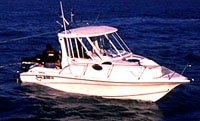
Doral Thundercraft 240HT
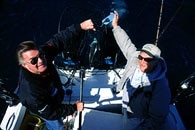
Doral Thundercraft 240HT
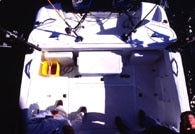
Doral Thundercraft 240HT
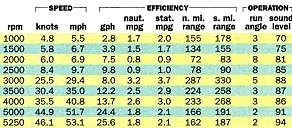
Doral Thundercraft 240HT Specs
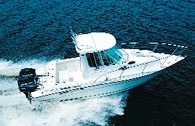
Doral Thundercraft 240HT
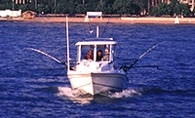
Doral Thundercraft 240HT
Some places are so damned fishy that even speaking their names sounds like a heathen incantation aimed at conjuring the angling gods. Montauk. Ocracoke. Islamorada. Franklin Park, Illinois. What was that last one again? To many, sportfishing brings to mind blue water, a tuna-towered convertible, and an angler tethered fast to a leaping marlin. The Great Lakes? Nah! Last we heard, the water’s so polluted it catches fire. And all those big cities…what could be worth catching there? Plenty. Or so we were told. To see for ourselves, we rigged a Doral Thundercraft 240HT with the latest gear and set out from the biggest big city on the lakes: Chicago. Our quarry? The hard-fighting, gastronomically correct salmon. Will a trip to the lakes get your drag singing, your heart thumping, and your charcoal grill sizzling?
A LITTLE HISTORY
Cleveland’s waterfront caught fire over a decade ago. Fish carcasses washed up on Great Lakes beaches because of hypoxia and other pollution-related diseases. And no one doubted that, for more than a century, our quintet of inland seas was used largely as a communal toilet by the scores of Rust Belt manufacturers ringing its shores. The fisheries suffered accordingly. Yeah, some people call that progress.
But things have changed. Legislation, most notably the Clean Water Act, a ban on phosphate-laden detergents, and a shift in manufacturing to overseas locations, has allowed the water quality of the Great Lakes to improve dramatically since the 1970s. Apparently, the hand of man can give as well as take.
It should come as no surprise, then, that the biggest, baddest, best-tasting gamefish in the Lakes-coho and chinook salmon-are present in fishable numbers only because of human intervention. Sure, Lake Ontario has a native Atlantic salmon population. That lake has been naturally connected to the ocean by the St. Lawrence River for eons. But it’s the stocking of the non-native, Pacific imports that’s created a world-class fishery that makes running or trailering your boat to Rochester, Green Bay, or even Franklin Park worthwhile.
How many fish are there? According to a report published by the Michigan Department of Natural Resources, coho and chinook have been stocked to the tune of 18 million fish per year-that’s nearly 55,000 fish per day, since the mid-1960s. The current total biomass is estimated to exceed half a billion fish.
Why such an intensive effort? Money. The revenue generated from salmon fishing in Michigan alone is estimated at $4 million per year. Head up to any of the cities bordering the Great Lakes and you’ll find no lack of marinas, launching ramps, or tackle shops. Yep, the fish are numerous. And you don’t have to go out to the boonies to catch them. Better still, they fight hard and grow big. Though most fish caught average under 10 pounds, coho salmon, also known as “silvers,” can reach 20 pounds, and chinook, a.k.a “king salmon,” often exceed 40 pounds, according to Capt. Mike Okoniewski of the Sagittarius Charter Service in Chicago. Big or small, plan on filling your cooler. Size and catch limits vary according to species and state, but most are generous. That means keeping the kids and beginners interested will be easy. Which leads to the best part about big-city Great Lakes salmon fishing: You can kill ’em and grill ’em with a clear conscience. Unlike most sport fisheries, this one is primarily put and take. Why? Because, simply put, after spawning, salmon die.
So the fish are plentiful, worthy game, and great to eat. Pursuing them in the shadow of skyscrapers means you won’t lack for services or amenities. And all the post-fishing activities of an urban hub are at hand. How do you get started?
HIT THE DECKHOUSE
Before you can tangle with kings, you need the right equipment. Even though you’ll be fishing within sight of land, Great Lakes salmon fishing is more akin to offshore angling than it is to most lake or coastal bay fishing. You break a jettied inlet and the only thing you see over the bow is the horizon. The water is cold and deep. The long fetch is like a handle, providing the wind with the grip it needs to build big, steep, short-period waves quicker than you can get to port.
Although any seaworthy fishboat of 20′ or longer can serve your purpose, sharpies like Capt. Joe Penar, of the charter boat After U II in Franklin Park, prefer solid, self-bailing models that sport a deckhouse and hardtop. If the center console exemplifies coastal angling, the hardtopped, inboard-powered, full cabin fishing cruiser is the darling of the salmon fleet. Here, boats from such makers as Penn Yann, Osprey, and Shamrock rule. The hardtopped deckhouse provides weather protection. Is this necessary? Well, in Chicago the season can start on St. Patrick’s Day and continue past Thanksgiving. “The water’s 34 degrees in spring,” notes Bob Caron of the Chicago Charterboat Association, “so expect ice in your rod guides.” Bulkheads ward off chilling spray better than canvas. They also provide better visibility. You can’t mount a windshield wiper on Eisenglass. And those steep, close-together waves, typical of the big lakes, almost guarantee that your wiper motor never gets cold.
Those same seas are also the reason most pros prefer inboard engines, which provide better seakeeping. Their greater torque allows them to swing larger propellers. That means the boat can stay on plane and in control at a slower, more comfortable speed. Also, their heavier weight mounted low, and in the center of the boat, inhibits the tendency that lighter boats have to launch off wavetops. Catching air, even just a little, makes any ride rougher. The centered weight provides better lateral stability during long hours of trolling than aft-mounted stern drives or outboards. “We fish only a few miles offshore,” says Capt. Stefan Thorsen of the charter boat We Three out of Milwaukee. “But a small, lightweight boat can make it seem like a real journey.”
******A BREAK WITH TRADITION**
For our run, we chose the Doral Thundercraft 240HT, powered by twin 150-hp Mercury Optimax outboards. Its solid-sided hardtop-more like a deckhouse-and open self-bailing cockpit provided comfort, safety, and ample space for our four-man crew to deploy a seven-rod spread. The standard aft cooler bench, which is also plumbed as a livewell, was big enough to chill our 40-salmon limit. Rocket launchers across the hardtop’s leading edge kept the requisite landing net and spare rods handy. At 8’6″ wide, this 23’6″ fishboat’s beam-to-length ratio proved stable on the troll. The break came in the form of the Thundercraft 240HT’s outboard power. Its 50-plus-mph top speed-impressive considering we were loaded down-made quick work of the morning run offshore. Further-more, we had to pick up our spread and run to several spots before locating the schools, so its speed definitely factored into our success. But during the run home, I was wishing for the steady, insistent ride of an inboard. Like many outboard boats, the Thundercraft 240HT performs best either trolling or up and going over 20 mph. There’s no middle ground. That made for a bumpy ride home in the afternoon’s rising breeze and four-foot, close-together waves.
Despite this, it’s a good choice. Most anglers aren’t as species- and area-specific as Great Lakes salmon hounds. With its trimmable outboards, the Thundercraft 240HT can fish shallow water as well as deep. Also, it’s more easily trailered and launched than an inboard, and it’s more representative of the type of craft BOATING readers might haul behind their truck during a salmon fishing vacation.
LOA …..23’6″** Beam** …..8’6″ Draft …..1’10” Displacement (lbs., approx)……….3,646 Transom deadrise…18° Bridge clearance…5’7″ Minimum cockpit depth..2’2″** Max. cabin headroom…5’0″ **Fuel capacity (gal.)…100 Water capacity (gal.)..13 Price (w/o power)………. $21,830 Price (w/test power) ……….$47,117
STANDARD POWER: None
OPTIONAL POWER: Single or twin Mercury or Mariner gasoline outboard motors to 300 hp total.
TEST BOAT POWER: Twin 150-hp Mercury Optimax gasoline outboards with 153 cid, 3.50″ bore x 2.65″ stroke swinging a 14 1/4″ by 21″ three-bladed, ss Quicksilver prop through a1.87:1 reduction.
STANDARD EQUIPMENT (major items): Hydraulic steering; 3-step ss swim ladder; six 8″ ss cleats; 4 gunwale-mount rodholders; under-gunwale rodracks; coaming bolsters; 2 insulated stowage boxes; baitwell; fishbox; removable aft cooler bench w/livewell plumbing and backrest; pumpout MSD; galley w/sink and pressure water; tilt helm.
For more information, contact: Doral, Dept. B, 1991 Third Ave., Grand-Mere, Quebec G9T 2WG, Canada, 819/538-0781, www.doralboat.com
ACCOUTERMENTS
Once you’ve determined that your boat’s design is suitable, you’ll need to equip it for salmon success. Two essentials are downriggers and planer boards. Planer boards are pairs of 3′-long plastic planks with beveled leading edges that are connected together so that the boards are slightly offset. These are tethered to the boat with a 200-pound test Dacron towline. When placed in the water while the boat is underway, planer boards “plane” out to the side of the boat, like horizontal aquatic kites. Release clips affixed to the tether allow you to connect one or more fishing lines and present a trolled lure wide of the boat’s wake. When a fish hits the lure, the line pulls free of the release clip and you fight the fish directly from the rod, unencumbered by the planer board. We used Cannon’s collapsible Plane-R-Boards ($150/pair, 208/887-1000, www.cannondownriggers.com), which we found easy to deploy and stow, and tied them off to the hardtop.
Basically a boom and winch for raising and lowering a 10-pound weight, a downrigger does vertically what planer boards do horizontally. Releases attached along the cable or to the weight allow you to connect your fishing line and present your trolled bait deep. Again, when a fish strikes, the line releases and you’re free to fight your salmon unencumbered- that is, as long as a “smoker” doesn’t wrap around the cable and weight.
For this reason, some anglers prefer electric downriggers, which allow the cable and weight to be retrieved at the flip of a switch. However, easier-to-install manual models, such as the Cannon UniTroll HP’s ($250) we used work fine. We placed a pair on gimbal mounts ($55) inserted into two of the Thundercraft 240HT’s four standard, gunwale-mount rodholders. UniTrolls feature a handle-operated clutch that made retrieving a one-handed operation. When a fish struck, we could grab the rod with one hand and crank up the weight with the other to clear for battle. And the standard depth counter allowed us to precisely lower our lures to the thermocline, the area between layers of water with distinct differences in temperature and, hence, density, where schools of salmon are most often found on the feed.
To locate the thermocline you’ll need what’s arguably the most important piece of salmon fishing gear: a high-resolution, high-powered fish-finder. With 240 vertical pixels and 650 watts RMS of output power, the Bottom Line Tournament Master HR ($600, 208/887-1000, www.bottomlinefishfinders.com) installed aboard the Thunder-craft 240HT fit the bill. We “peaked” its transducer by first doubling the depth range in manual mode, then increasing the gain until the display showed a second bottom echo, and finally returning the scale to the depth we were fishing. The thermocline appeared as a thin, wavering line 31′ below the surface. The fact was confirmed as strike after strike occurred using these techniques.
Rods for this adventure are salmon specific. “What you want are 7’6″- and 8’6″-long rods designed for 20-pound line,” says Penar. “It needs a heavy butt in case a 30-pound king comes along but must have a fast, light tip to prevent tearing hooks loose on smaller fish.” The reel, too, must have a dependable drag and enough line capacity to handle a 100-yard run. We used Abu Garcia’s 7000C reels ($155) mounted on Fenwick DR82C rods ($90) designed specifically for downrigger fishing. Terminal tackle consisted of a green, green-and-blue, or white fly connected by 20″ of clear, 40-pound leader to a dodger – a flashy, in-line attractor that darts back and forth. Hardware and hard work are at the heart of Great Lakes salmon fishing.
THE PAYOFF
Once we found the schools – and we did, thanks to all of our preparations-the action was virtually nonstop. Double headers were common, and there were several times when three lines popped their clips at once. As captain, manage your crew to avoid cockpit chaos when the bite is hot. We didn’t catch any screamers, but if the jarring strike of their coho cousins is any indication, a trolled-up king is definitely a noble adversary. Maybe we needed to beseech the gods with a chant. Chin-ook, chin-ook, chin-ook….









